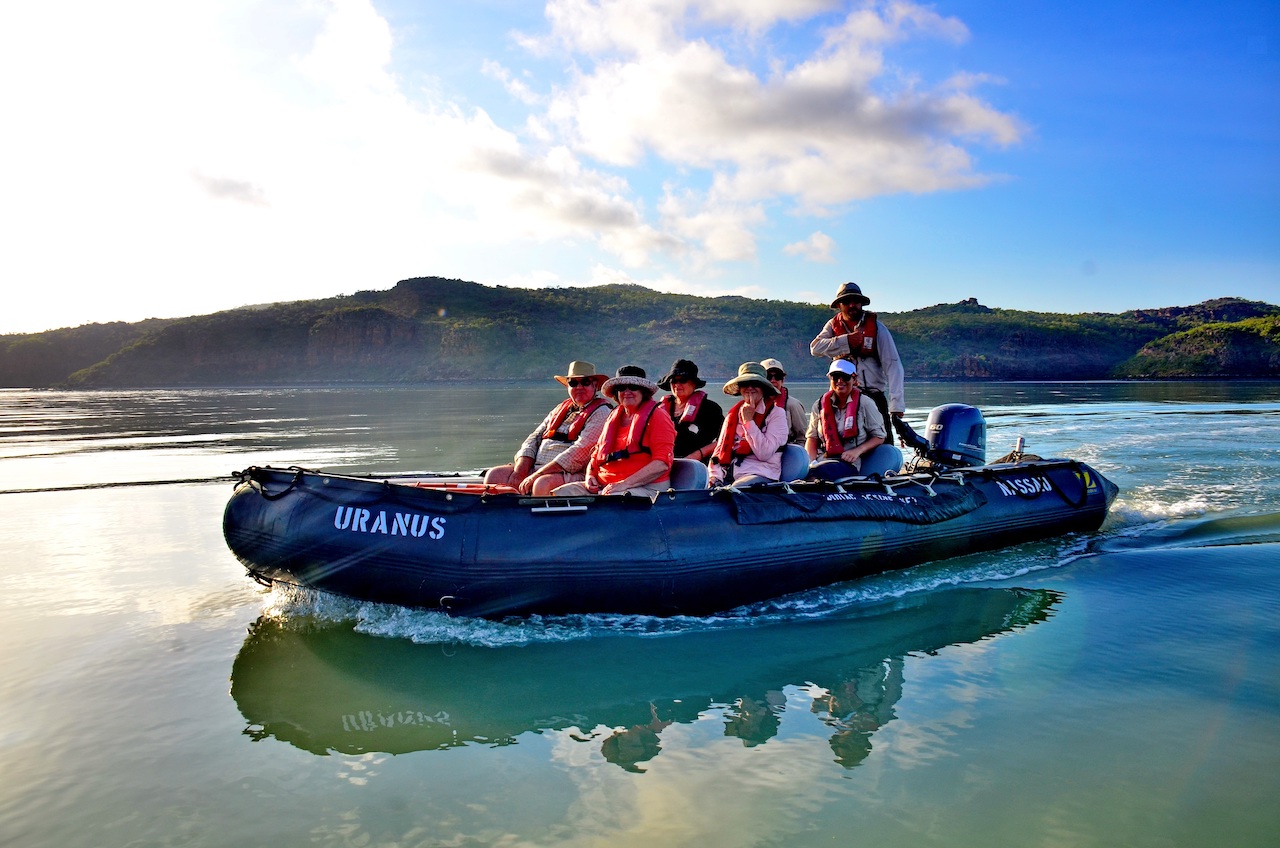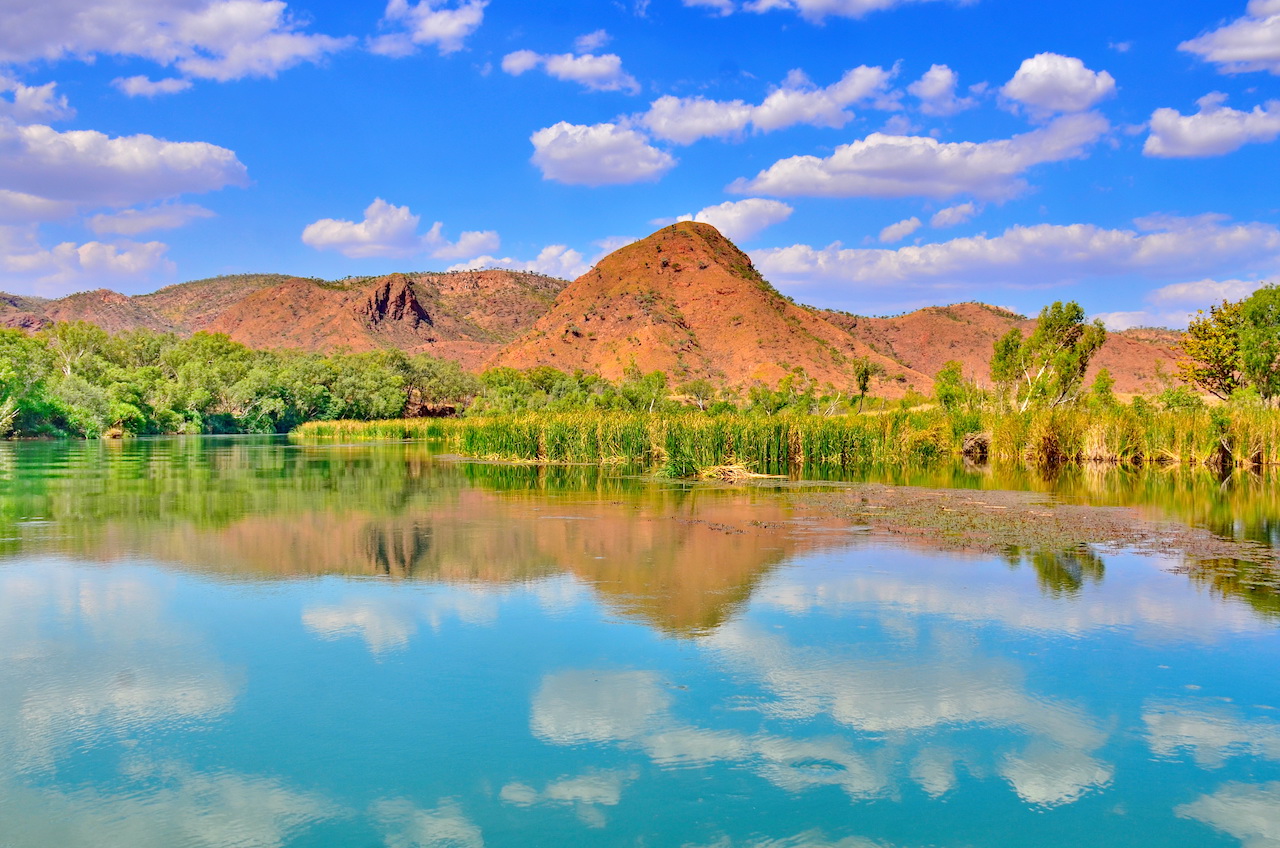The Kimberley is home to some of Australia’s most stunning landscapes, unique, often misunderstood wildlife, and an outback spirit that continue to draw intrepid travellers from across the globe, discovers Nick Walton.
I’ve decided to call the shark Kenny. It’s as innocuous a name as I can dream up as I watch the giant predator slowly samba his way beneath the ship, only to pop out the other side and circle around for another pass. Kenny has been following us for the better part of two days, lazily dipping below the zodiacs as they launch from the stern of the MV Orion (now National Geographic Orion), his elegant curves easily spied through the crystal clear water, cast in shadow thanks to a beating outback sun. Crew tell me he’s harmless, a nurse shark, but they can’t look me in the eye as they say it, and no one is volunteering to take a dip and pet our new-found friend.
The Kimberley is a wild place filled with wild inhabitants, which is what makes it such a popular destination for adventure cruise passengers looking for captivating landscapes and the chance to commune with nature. It’s also a point of national pride for Australians, who make up the majority of the 90 passengers boarding the ship in Darwin. Aussies are justly proud of their beautiful backyard, and many who have cruised to the world’s farthest flung corners, return to the Kimberley coast time and time again.
Of course, Australia has that allure for many people, so in addition to the locals, there are Canadians and Americans, a spattering of Europeans, a couple from Hong Kong, and a lone Japanese grandmother who has travelled with the Orion, which joins the Lindblad National Geographic line in March, four times before. This mix of interesting, well-travelled souls comes in handy as we kill the first two days and two nights at sea thanks to a rather ridiculous local law that means the Orion has to leave Australian waters at some stage during each Kimberley cruise – in this case with a 15 minute late night visit to the tip of East Timor. It also means we all have our sea legs by the time we return to the blazing red rock and open skies of the Kimberley and the first port of call on our 11 day itinerary, the once prosperous town of Wyndham.

Here, the ship’s 90 passengers split; some take to the skies to fly over the acclaimed Bungle Bungle Range, the distinctive beehive-shaped towers in the Purnululu National Park, while others bus pass thundering road trains carrying iron ore to cruise the Ord River in search of fresh water crocodiles and birds of prey. My father Rob and I, travelling together for the first time in decades, opt for the river, clambering into high speed, open-sided tour boats to cruise part of the Ord’s 320 kilometer reach, towards Lake Argyle, a manmade body of water that irrigates vast tracks of surrounding farmland.
The lake is tranquil and beautiful, the few clouds in the brilliantly blue sky joining grassy hillocks and red rock cliffs in a picture-perfect reflection on the water. We spy graceful egrets and rainbow bee eaters, square tailed kites, northern rosellas, and delicate azure kingfishers dancing through a canopy which arches over the river’s narrower tributaries. Some of the Ord’s estimated 25,000 fresh water crocodiles, smaller and more demure than their salt water cousins, bask on the river banks in the mid-day sunshine, while nearby, gangs of pelicans ensnare fish by creating tight rings before diving together like synchronized swimmers.
The next day is a chance to explore the King George River and its famed falls. It’s our first time cruising in the ship’s fleet of zodiacs; each named for a different constellation, the zodiacs are a vital component of the expeditionary cruise operation, and allow guests to reach far up rivers and land on deserted beaches. It’s early morning as we make our way up the gorge, red cliffs towering on either side, black lines on the ancient rock testament to some of the world’s highest tides. From the zodiacs, the keen-eyed expeditionary staff point out snowy white ospreys and shy rock wallabies. After a steep climb up a sheer rock face, we’re able to take in the staggering view from atop Australia’s most famous waterfall, and even though the falls are dry, we join gleaming water monitors in cooling our heels in pools of captured rain water. Back at the river, the ship’s maître’d, Clinton, emerges from behind a rocky crag and surprises us with chilled mimosas.

Between shore excursions, guests soak in the outdoor jacuzzi, lunch on the back deck under a canopy of umbrellas, or attend lectures on local ecosystems, marine life, historic events from the region, and the Aboriginal people who called the Kimberley home. Each night guests come together for a cocktail hour in the ship’s Leda Lounge and a fun-filled debrief on the adventures of the day followed by dinner, either in the main dining room or on the back deck under a canopy of stars.
As comfortable as the ship is, with its elegantly appointed guest rooms – for true pampering you can’t go past the Owner’s Suite with its separate living room and Juliette balcony – passengers come to the Kimberley to explore, whether it’s the 40,000 year old Bradshaw Aboriginal art of Vansittart Bay, or scrambling through the fuselage of a wrecked WWII DC3 that crashed on a sprawling mudflat inhabited by millions of tiny scurrying orange and azure-coloured crabs.
It’s an early start the next morning to make our zodiac run up the Hunter River with the low tide. There is also an option to fly by helicopter up to the Mitchell Falls, a four-tier fall which tumbles down from a high inland plateau, and we watch helicopters shuttle guests from a deserted beach near the ship. The Hunter is popular with expeditionary cruises because of the diversity of its wildlife; from our convoy of zodiacs, led by expedition leader Darrin Bennett, whose infectious passion for the Kimberley has been forged from years exploring the region, we catch glimpses of whistling kites and white-bellied sea eagles perched on large nests high up on the cliffs which form the gateway to the river. Further on, beneath dense mangrove forests, lazy crocodiles doze on the mud, basking in the early morning sun as white goshawks glide in the thermals above, looking for breakfast.

It’s not just the fauna that’s wild in the Kimberley; some of the world’s most unique and awe-inspiring geological formations can also be found at the top of Western Australia, including the Montgomery Reef, located 20 kilometers off the coast of Doubtful Bay, and Talbot Bay’s Horizontal Waterfalls.
We set out early under baby blue skies to explore the Reef, stopping briefly to watch a pod of humpbacks breeching nearby, their tails slapping at the calm waters of the bay. Then, like an alien craft, long submerged and forgotten, the tide shifts and the reef begins to appear from the depths. The movement of the ten-metre tide means this expansive stone island quickly emerges from the seas as we venture up newly formed rivers between coral outcrops, torrents of water flooding from its flanks, turtles and reef sharks frolicking in the shallows at its fringes. Nearby, Clinton and his team camp on a sand bar and serve chilled bloody marys and warm sausage rolls.
In Talbot Bay, the ship’s captain, Taillard Vincent, navigates through the islands and narrow channels of the Buccaneer Archipelago, home to the Horizontal Waterfalls. As the tides rise and fall, the pressure of water passing through three narrow gaps between inland seas increases, creating a towering rush of water dubbed a horizontal waterfall by David Attenborough. In fact, the flow becomes so strong that the ship’s French military-grade zodiacs can’t pass through, so guests roar through the gap, thumping down to the new water level on the high speed boats of a local tour operator. It’s an exhilarating ride as the boat lines up with the narrow gap before sprinting and bouncing its way up or down the ‘waterfall’ and onto calmer seas. Back at the ship, Kenny makes another pass below as I step from zodiac to transom while nearby a sea snake as thick as a fire hose tangos his way past, his yellow and black stripes blazing under the sun.

The rock formations, the ancient landscape, and the Kimberley’s unique inhabitants are food for thought as we cool off on our last day in the ironically named Crocodile Creek, an idyllic pool fed by a natural spring that’s protected from its reptilian namesake by a series of embankments. Wreathed by vivid red Kimberley Rose trees, it makes for the perfect place for a final dip and the last of Clinton’s surprises; in this case margarita’s served from a bar perched on twin inflatable crocodiles.

